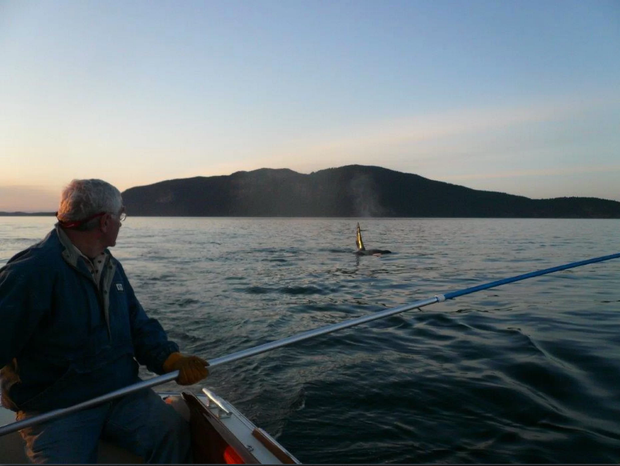Blowhole "breathalyzer" shows salmonella in killer whales
Unfortunately for biologists, it’s not really possible to get wild killer whales to come in for a checkup. But to test the health of orcas, you can apparently give the creatures a breathalyzer.
That’s what a group of scientists did with an endangered population of orcas, known as southern resident killer whales, in the Salish Sea.
The researchers captured microbes spurting out of the whales’ blowholes. Results showed that the species carries some of the same pathogens that cause disease in humans, including Salmonella and staph bacteria, according to the study published online March 24 in the journal Scientific Reports.
Southern resident killer whales live off the western coast of British Columbia, Canada. Their population may have once numbered in the hundreds, but the species faced a series of setbacks in the second half of the 20th century.
In the 1960s, a live-capture fishery removed nearly 50 of the whales for display at marine parks, according to a report from the U.S. National Marine Fisheries Service. The population started to make a comeback, but then in the 1990s, the whales mysteriously went into decline again, and they were put on the U.S. Endangered Species List, the researchers in the new study said. [Orca Gallery: See Gorgeous Photos of Killer Whales]
Now, estimates from the latest annual survey suggest that just 78 southern resident killer whales remain in the wild. (That population no longer includes “Granny,” who was thought to be the oldest known orca, but was presumed dead at 105 years old in October 2016.) The small population size makes disease a big concern of conservation biologists.
The leader of the new study, Stephen Raverty, an adjunct professor at the University of British Columbia’s Institute for the Oceans and Fisheries, said his team wanted to find out what kind of bacteria and fungi were present in healthy whales to establish a baseline. The researchers also wanted to document the potential pathogens the orcas were being exposed to in their environment, he said.
“In some circumstances, these pathogenic microbes could pose a threat to the animals and contribute to clinical disease,” Raverty said in a statement.
So, over the course of a few years, Raverty and colleagues snuck up on surfacing killer whales and held out a long aluminum pole topped with a petri dish. The researchers positioned the dish just above each whale’s blowhole so that it would catch any microbes let out by the whale as it exhaled.
The results from the scientists’ 26 samples showed that the whales were carrying bacteria that can cause disease in humans and animals. These bacteria included Salmonellaand Staphylococcus aureus (the bacteria that causes staph infections). The whales also carried some fungi, like Phoma, which is usually found in soil, the study said.
“We’re not sure if these microbes naturally occur in the marine environment or if they may be terrestrially sourced,” Raverty said in the statement. “These animals are long-ranging, and as they migrate along the coast, they are exposed to agricultural runoff and urban discharge, which may introduce a variety of microbes into the water.”
Though more work is needed to confirm the source of the microbes, the scientists also found some strains of antibiotic-resistant bacteria, which suggests human contamination in the environment, the researchers said.
Original article on Live Science.
